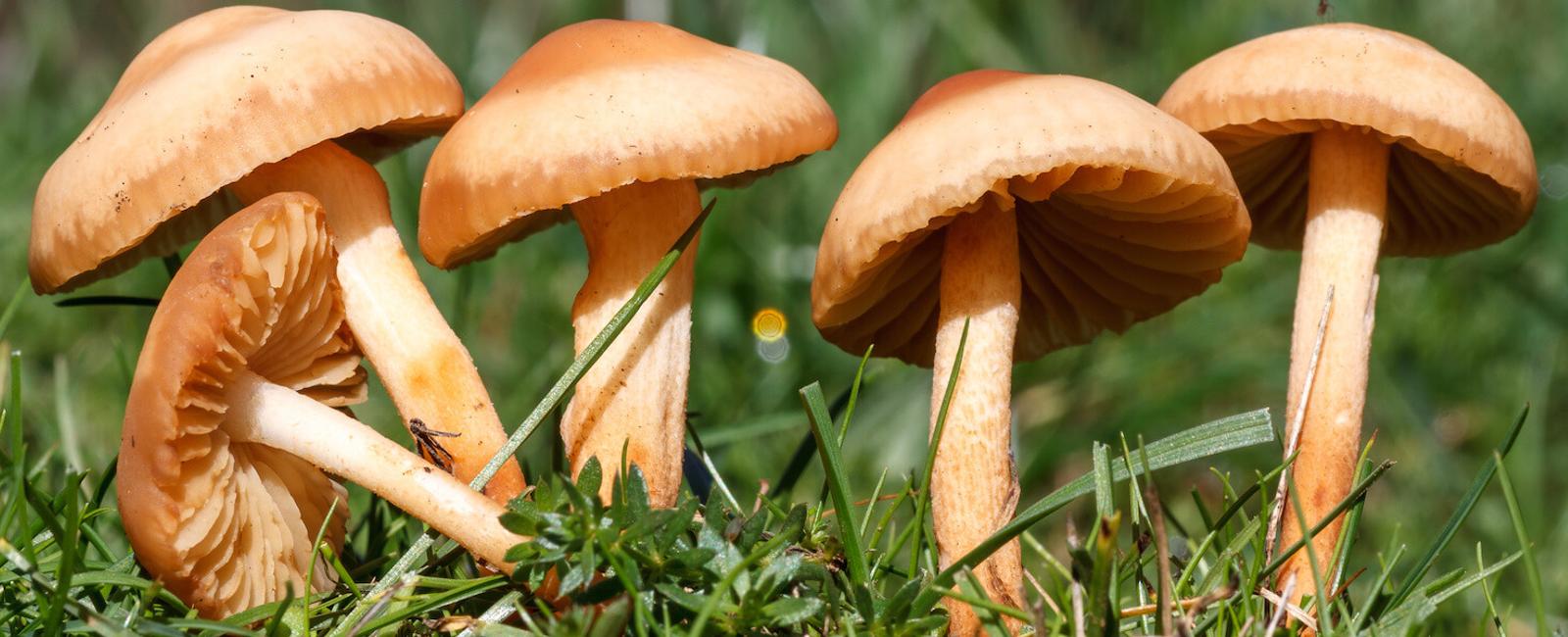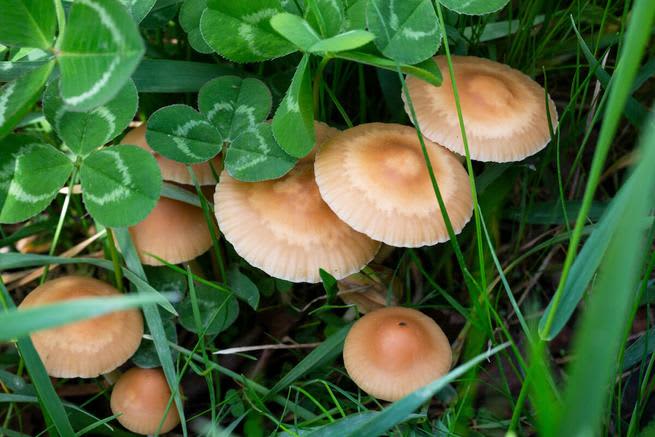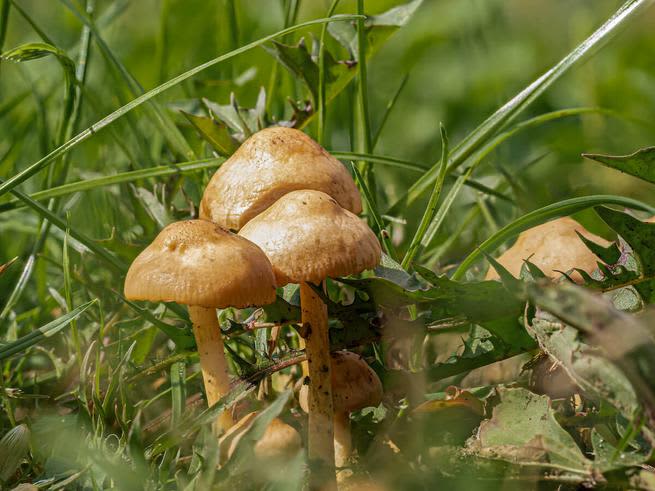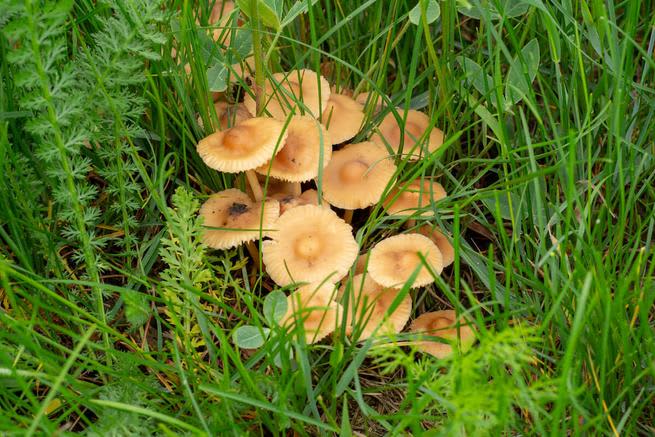

Traditional European folklore often talks about mysterious mushroom rings in the heart of lush meadows and woodlands, where fantastic (and terrifying) creatures dance and rejoice. We can’t speak for these mythological beings—but the famous fairy ring mushrooms are certainly worth keeping an eye out for.
These tiny fungi are known for their sophisticated taste and distinctive growth pattern, making them the perfect choice for novice and veteran mushroom hunters alike. Yet modern research also shows that fairy ring fungi could have several health benefits. Here’s what you need to know.
What are fairy ring mushrooms?
Fairy ring mushrooms, also known by the scientific name Marasmius oreades, are an edible fungi species native to North America and Europe. Unlike many of the mushrooms we’ve covered, fairy rings have a distinctive sweet taste that makes them suitable for recipes such as cookies or cakes.
Their curious common name refers to their circular growth pattern, which has lent itself to dozens of folklore stories involving fairies, wood nymphs, and leprechauns. However, you may also find it labeled as Mousseron mushroom, Scotch bonnet, and Marasme des Oréades. The circle itself is often called a pixie ring, elf ring, witches’ ring, and fairy ring.
But the growth pattern and taste aren’t the only interesting attributes of fairy ring fungi.
Unlike most mushrooms, M. oreades can revive after being completely dried out. Experts theorize that this may have to do with a special type of sugar (trehalose), which would allow it to withstand the damage related to lack of liquid (1).
Furthermore, recent research shows that the species may have many health benefits. These include antioxidant, anticancer, antimicrobial, and antibiofilm properties, along with a balanced nutritional profile (2).
Fairy ring champignons are widely considered choice edibles, with a sophisticated sweet flavor that makes them ideal for baked recipes. They can also be served as an accompaniment for delicate meat and fish dishes or as an ingredient in mushroom salads and sauces (3).
How does Marasmius oreades look?

Fairy ring mushrooms are relatively small fungi with a cap measuring no more than 5 cm (2 in). The margins initially grow convex (bell-shaped), flattening out as the mushroom ages. The color is pale tan, with some specimens tending towards complete white or a reddish tan.
The stem or stipe is 2–8 cm (0.8–3.1 in) long, thick, and the same color as the cap. As you may have noticed, fairy rings look somewhat generic. Expert mycologists often recommend looking out for the distinctive ring pattern paired with decurrent gills, or gills that extend down the mushroom’s stipe. It also has an entirely white spore print (4).
What are the varieties of fairy ring mushrooms?

No known varieties, subspecies, or strains of M. oreades exist. However, over the years, several mycologists have classified or described the species under different names. As such, you may find fairy ring mushrooms labeled as:
- Agaricus oreades
- Collybia oreades
- Scorteus oreades
- Agaricus caryophylleus
- Chamaeceras caryophylleus
- Marasmius caryophylleus
These are all considered synonyms of M. oreades, meaning they are the same mushroom (5).
History of fairy ring mushrooms

Naturally, the curious growth pattern of M. oreades has spawned dozens of folklore stories involving all kinds of mythological creatures.
According to experts, ancient European tradition relates fairy rings to several supernatural causes, such as elves’ spittle, lightning strikes, or the dancing of fairies and witches. In the Netherlands, fairy rings were often associated with dragons and the Devil.
While one would think that the fairy ring name indicates a good thing, folk tradition implies the opposite. Supposedly, the fungi patches would inflict retribution on all who entered—more specifically, people believed that trespassers would be punished with the loss of an eye.
Other traditions indicate a more extreme belief, sharing a common pattern of demise concerning the person who dared to trespass the ring of mushrooms. Many tales describe travelers finding a group of spirits dancing within the circle—and, upon trespassing, being forced to dance with them until they turned to dust.
However, if left untouched, fairy rings were actually supposed to bring good luck, abundance, and fertility. Landowners would go as far as not letting cattle pasture near them to avoid disturbing the spirits and creatures related to the circle of mushrooms (6).
As for its mycological history, the first official mention of M. oreades dates back to 1792, when English botanist James Bolton described it under the name Agaricus oreades. A few years later, in 1832, renowned Swedish mycologist Elias Magnus Fries transferred it to the Marasmius genus, completing the description (5).
Health benefits of fairy ring mushrooms

Fairy ring fungi are considered to be “functional mushrooms”—species with significant nutritional and health benefits. While research on M. oreades is few and far between, mycologists point out that it could be one of the most promising mushrooms we’ve covered so far.
Unfortunately, we couldn’t find any detailed breakdowns regarding fairy ring fungi’s exact chemical and nutritional composition. Yet, we know that dry M. oreades comprises about 52% crude protein and 11% ash. It also provides several micronutrients, including (7):
- Phosphorus
- Potassium
- Calcium
- Chromium
As for the health benefits, a 2019 study took a close look at the phenolic and flavonoid composition of M. oreades. Surprisingly, the authors found that these bioactive compounds brought on a myriad of health benefits, which doctors could take advantage of by using extracts.
The most fundamental benefit of fairy ring mushrooms is probably their antioxidant activities, which come from phenolics such as catechin and ferulic, gallic, and vanillic acids. Antioxidants may be a valuable tool in treating conditions such as cancer and Alzheimer’s disease. However, the authors state that M. oreades may not be as effective in live cases as during the trial.
But M. oreades really shines when it comes to dealing with bacteria. Different extracts of fairy ring fungi are effective in combating pathogens such as Escherichia coli, Staphylococcus epidermidis, and Pseudomonas aeruginosa. As is often the case with mushrooms, M. oreades was more effective in dealing with Gram-positive bacteria than Gram-negative ones.
The difference between these types of bacteria is that Gram-negative ones have an outer layer that makes them much more resistant. As such, it’s no surprise that M. oreades isn’t as effective in dealing with them—these bacteria can puzzle even the most complex antibiotics.
Similarly, the authors indicate that fairy ring mushrooms have antibiofilm benefits, which help prevent pathogens and bacteria from adhering to the surface of organs. Combined with the antimicrobial effects, this could make M. oreades a promising tool for treating bacteria-related conditions.
The anticancer effect of M. oreades acts similarly to the antimicrobial properties. The authors theorize that fairy ring extract could both inhibit and help tear down the cell lines of tumors. However, they don’t go into much more detail (2).
Although these benefits are very promising, it’s crucial to remember that research is still in its early stages. If you want to use M. oreades (or any other mushroom) to treat a specific condition, check with a doctor first.
Where do fairy ring mushrooms grow?

Fairy ring mushrooms are widespread in Europe and North America. They’re year-round mushrooms in warmer climates—but in colder regions, they may only fruit during summer and fall.
They are saprobic mushrooms, meaning they live off dead grass and other decaying organic material. Experts point out that lawns, meadows, and other grassy areas are the perfect growing grounds for M. oreades. It may even appear on pesticided areas such as golf courses.
Although the circular growth pattern is one of the most recognizable aspects of the species, it may also grow in troops and arcs. However, remember that M. oreades isn’t the only mushroom that creates fairy rings, and some species that do are toxic!
What is ethical wildcrafting?
Ethical wildcrafting refers to harvesting natural resources from the environment without damaging the surrounding ecosystem. Many people confuse wildcrafting with foraging—the difference is that the first refers to harvesting for medicinal purposes and the latter for eating.
The goal of ethical wildcrafting is to ensure the health of local animal, mushroom, and tree populations. If you’re new to harvesting wild fungi, don’t worry. Practicing ethical wildcrafting is as simple as following these guidelines:
- Research the species before going out on the field. Make sure you take note of any poisonous or endangered lookalikes you may come across.
- Get your hands on a mushroom field guide. These small manuals can go a long way in helping you distinguish lookalikes while also teaching you about the surrounding ecosystem.
- Avoid overharvesting! Take only what you need, and don’t share patch locations with friends and family.
- Pick the fruiting bodies gently. Ideally, use your hands and save scissors and knives for when absolutely necessary.
- Stay in check with the legal side of harvesting. Check local regulations if you’re on public land and ask permission from the owner if you’re on private land.
As always, we recommend looking for local harvesting groups if you’re a newcomer to the fungi world. Veteran fungi hunters will usually be more than glad to show you the ropes and help you avoid dangerous lookalikes.
Is it safe to wildcraft for Marasmius oreades?
Unfortunately, eating wild fungi is never 100% safe, no matter the species. There’s always the risk of coming across a toxic or non-edible lookalike. In the case of M. oreades, the most common one is Chlorophyllum molybdite—a poisonous mushroom that can grow to be the same size and color as fairy ring mushrooms.
Other common toxic lookalikes are Clitocybe dealbata and Clitocybe rivulosa, which also grow in a ring pattern. The main difference with M. oreades is that these two fungi have decurrent gills instead of free ones.
Furthermore, wild mushrooms often carry toxins from the environment. Because M. oreades often grows in heavily-pesticided areas such as golf courses, poisoning cases related to the species are not uncommon. If you’re set on eating wild fairy ring mushrooms, make sure you wash and cook them thoroughly.
How do you take fairy ring mushrooms?

Fairy ring mushrooms have a chewy and tender texture and a spicy yet sweet scent that closely resembles cinnamon. The flavor is subtly sweet, earthy, and nutty, making them the perfect choice for baked recipes ranging from cookies to pizza.
You can cook fairy ring mushrooms in several ways, from braising to frying. They are relatively forgiving fungi, as they pair with almost any ingredient. But if you’re new to cooking with toadstools, here are two recipes to get you started:
Fairy ring and rice stew
Place some chopped carrots and onions in a wok pan with some oil and saute over medium heat while you wash the fairy ring mushrooms. Add the fungi and cook until the mushrooms turn brown. Add rice with enough water and let the whole mixture simmer until the rice is done. Add salt, black pepper, and thyme to taste.
Fairy ring mushroom soup
Cook the mushrooms with some minced shallots and butter in a heavy pot for about three minutes (add some water if using dried mushrooms). Add a few tablespoons of flour, stir for a minute, and add two cups of broth with thyme and salt to taste. Simmer over low heat for about ten minutes and serve with sherry.
As always, don’t be afraid to mix it with other types of fungus as well. Oyster, button, and shiitake mushrooms are the perfect companions to the sweet taste of fairy rings.
Fairy ring mushrooms: Dancing in circles
Fairy ring fungi are among the most sought-after edible mushrooms in the world. With a rich folklore history and a sophisticated taste, this fascinating species is sure to captivate even the most experienced mycologist. Moreover, research shows that these fungi could have significant nutritional and health benefits—what more could we ask for?
If you want to find out about other types of mushrooms, keep up on shroomer, where you’ll find all the latest news about psychedelic and functional fungi. From portobellos to magic mushrooms, you’ll surely find something that suits you.
References
- Thomas Volk. “Tom Volk’s Fungus of the Month for March 2003.” TomVolkFungi.net (2003). Recovered from: https://botit.botany.wisc.edu/toms_fungi/mar2003.html
- Naznoosh Shomali, Okan Onar, Başar Karaca, Nergiz Demi̇rtaş. “Antioxidant, Anticancer, Antimicrobial and Antibiofilm Properties of Culinary-Medicinal Fairy Ring Mushroom, Marasmius oreades (Agaricomycetes).” International Journal of Medicinal Mushrooms 21(6) (2019): 571–582. http://dx.doi.org/10.1615/IntJMedMushrooms.2019030874
- Antonio Carlucci. “Marasmius oreades.” in Complete Mushroom Book: The Quiet Hunt (2003): 62–63.
- Michael Kuo. “Marasmius oreades.” MushroomExpert.com (2013). https://www.mushroomexpert.com/marasmius_oreades.html
- Mycobank. “Marasmius oreades.” (Last accessed August 30, 2023). https://www.mycobank.org/page/Name%20details%20page/14947
- Adrian Morgan. Toads and Toadstools: The Natural History, Folklore, and Cultural Oddities of a Strange Association (1995): 11–31.
- Pavel Kalac. Edible Mushrooms: Chemical Composition and Nutritional Value (2016): 20, 46–47, 116.


